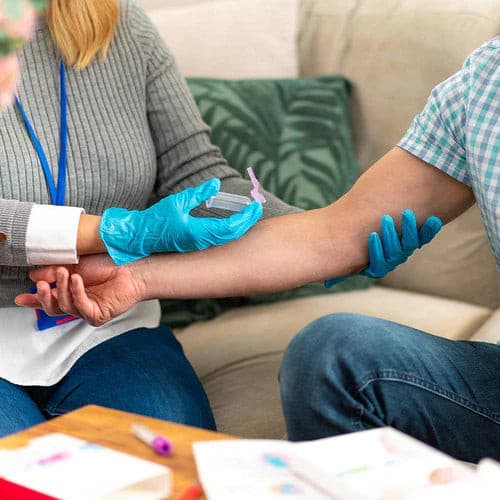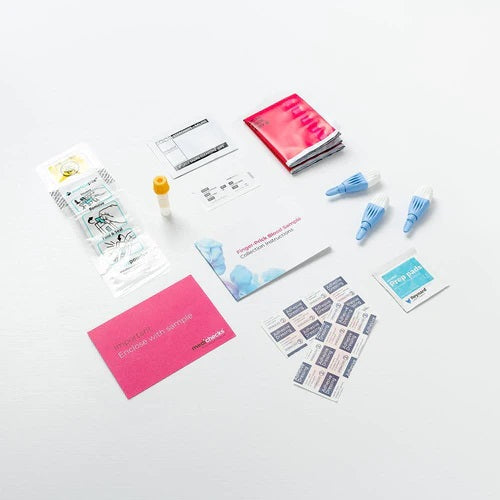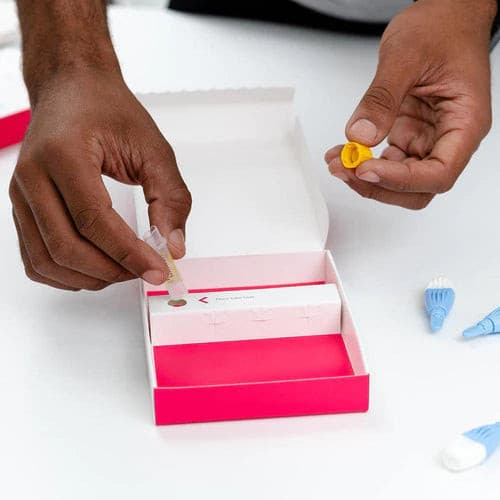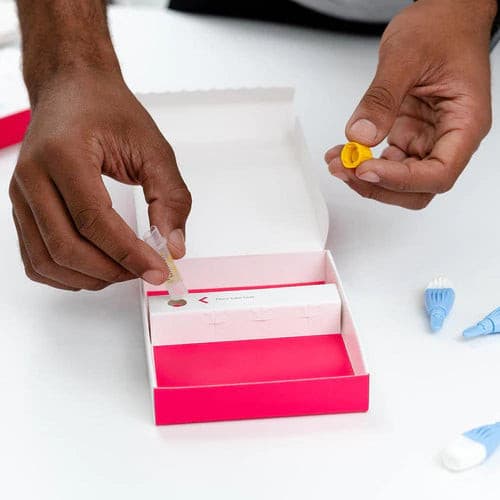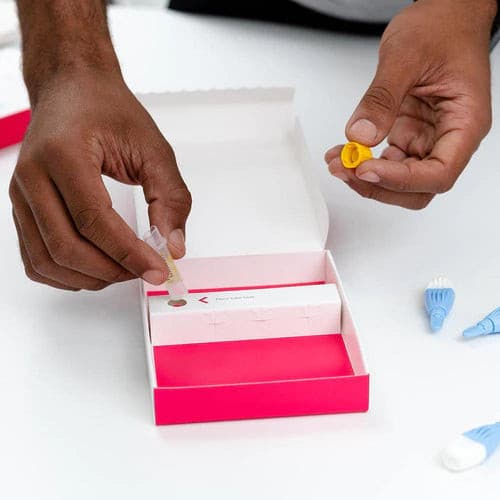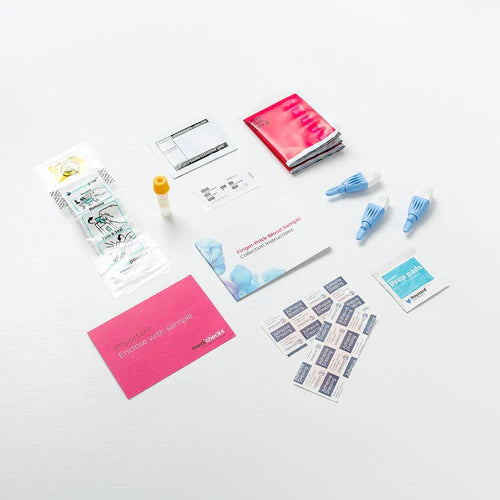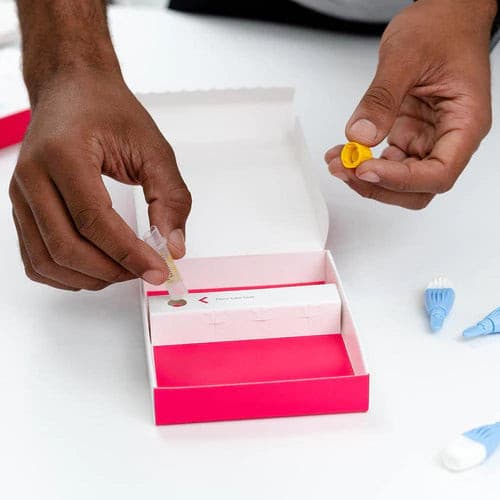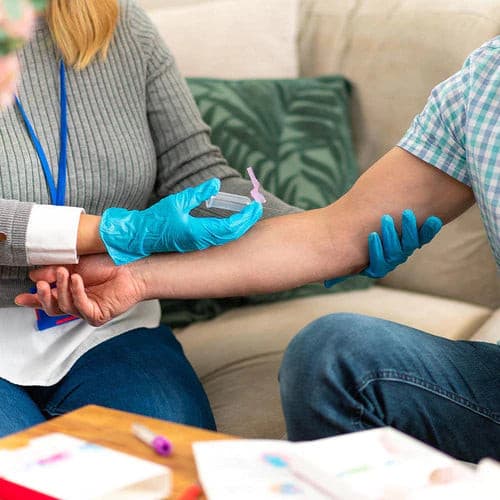
About Description
- full PCOS test with specialist counseling
- simple and low-cost test
Why People Choose Us

Quick & Easy
No appointment or long waiting times

Discreet Packaging
Plain packaging with no medical stamps or marks

Confidential Service
Your information stays with us and private payment

UK Medication
Dispensed by registered UK pharmacists
Hormones (7 Biomarker)
Every bodily function, including development, metabolism, reproduction, and sleep cycles, is controlled by hormones.
Your mood and energy levels, as well as your fertility and libido, can all be negatively impacted by even a slight hormonal imbalance. Chemical messengers known as hormones are produced in your glands and delivered into your bloodstream.
Your body receives instructions from them on how to control your appetite, growth, mood, and reproduction. In general, they maintain the body's equilibrium and functionality.
Hormone imbalances are frequently treated with hormone replacement therapy or by altering one's lifestyle. Throughout the day and for women during the menstrual cycle, hormone levels change.
LH
The pituitary gland produces the luteinizing hormone (LH), which is crucial for both male and female reproduction. It controls the menstrual cycle in women and peaks just before ovulation. It increases testosterone production in men.
FSH
The pituitary gland produces the hormone follicle stimulating hormone (FSH), which is crucial for both men and women in the development of sperm and eggs.
FSH increases the growth of follicles within the ovaries in the first half of the menstrual cycle in women.
Oestradiol levels will rise thanks to each of these follicles. Follicle stimulating hormone levels fall throughout the second half of the menstrual cycle as one follicle becomes dominant and is discharged by the ovary (ovulation).
In men, FSH stimulates immature sperm cells to mature into sperm by acting on the seminiferous tubules of the testicles.
Testosterone
A hormone called testosterone is responsible for male features. It plays a part in controlling bone mass, fat distribution, muscular mass, strength, the creation of red blood cells, and the production of sperm in men.
It also helps to regulate sex drive. Men's testicles and, to a much lesser extent, women's ovaries both produce testosterone. Although lower than normal amounts of testosterone can occur at any age and can result in low libido, erectile dysfunction, difficulties gaining and retaining muscular mass, and lack of energy, testosterone levels in males naturally fall after the age of 30.
Even though testosterone levels in women are significantly lower than in men, it is still vital for the same reasons—it affects libido, how fat and muscle are distributed, and how red blood cells are formed.
Because reference ranges are dependent on the population being tested, they will all somewhat vary between laboratories. 95% of men will fall inside the usual range, which has been determined.
We follow the British Society for Sexual Medicine's (BSSM) recommendations for greater consistency, which state that low testosterone can be diagnosed when levels are consistently below the reference range and that levels below 12 nmol/L may also be considered low, particularly in men who also experience symptoms of low testosterone or who have low levels of free testosterone.
Oestradiol
Oestradiol is a female steroid hormone that is made primarily in women's ovaries and only little in men's testicles.
The female reproductive system, breast tissue growth, and bone density are all influenced by this, the strongest of the three oestrogens. Oestradiol levels in premenopausal women fluctuate during the monthly cycle, reaching their highest point at ovulation.
Oestradiol levels in women decrease with ageing, peaking at menopause when the ovaries stop releasing eggs. Hot flashes, nocturnal sweats, and mood swings are just a few of the menopause symptoms that low oestradiol can bring on.
Osteoporosis can also result from low oestradiol.
Anti-Mullerian Hormone
The ovaries produce the hormone known as AMH, also known as anti-Mullerian hormone.
It is specifically made by the ovarian follicles that house the eggs. Levels might show whether a woman's ovarian reserve is high or low. Men's levels of anti-Mullerian hormone are not typically assessed.
Specialist reproductive clinics may use it to evaluate sperm production.
Free Testosterone Calc.
Only 2-3% of the testosterone that is circulating in the blood is free and available to cells; the majority is attached to proteins, particularly SHBG and albumin.
The method used in this test determines the ratio of free or unbound testosterone to total testosterone, SHBG, and albumin.
Prolactin
The pituitary gland produces the hormone prolactin, which is important for reproductive health.
Prolactin levels can skyrocket in pregnant and nursing women, and its main function is to boost milk production after delivery.
Proteins (4 Biomarker)
Proteins are essential for muscle growth as well as the operation of cells and tissues.
Blood proteins are measured to assist in the diagnosis of various illnesses, such as liver or kidney disease. It is common practise to analyse proteins to determine how much of a specific hormone is bound to a protein or free and thus available to your cells.
Proteins also transport other chemicals, such as hormones, throughout the blood. Dehydration is a common cause of elevated proteins, but they can also be a sign of other health issues.
A significant protein deficiency may be a sign of malnutrition or malabsorption.
SHBG
The majority of the sex hormones, including testosterone, oestrogen, and dihydrotestosterone (DHT), are bound to Sex Hormone Binding Globulin (SHBG), rendering them inactive in your cells.
The amount of free or unbound hormones, which are biologically active and available for usage, can be determined by measuring the level of SHBG in your blood.
Total Protein
The total protein in your blood is the sum of the proteins albumin and globulin. Among their many jobs, albumin and globulin keep blood in vessels, deliver nutrients, and combat infection.
A liver or renal problem as well as malnutrition may be indicated by abnormal levels.
Albumin
A protein called albumin is mostly produced in the liver. It aids in generating the osmotic pressure necessary to keep water in the blood.
It is crucial for tissue growth and repair and aids in the transportation of nutrients, medicines, and other chemicals via the blood. By evaluating albumin levels in the blood, we can determine how much hormone is available to your tissues.
Albumin also transports hormones throughout the body.
Globulin
The term "globulin" refers to a variety of proteins that the liver and immune system create. While certain globulins transport metals like iron in the blood, others bind with haemoglobin.
In addition, there is a specific class of globulin called an immunoglobulin, which is another name for an antibody and aids in the body's defence against infection.
Cholesterol Status (6 Biomarkers)
Total Cholesterol
LDL cholesterol
Low density lipoprotein, often known as LDL cholesterol, is a lipid and protein molecule that carries triglycerides, cholesterol, and other fats to various bodily regions.
When fatty deposits build up inside artery walls due to an excess of LDL cholesterol, sometimes known as "bad cholesterol," this could result in atherosclerosis and heart disease.
Through food and exercise, your cholesterol levels can be dramatically reduced. Likewise, if you can raise your levels, you may be able to avoid developing significant, potentially fatal illnesses in the future.Results for HDL and LDL (and non-HDL) can be used as benchmarks and improvement targets. Regular exercise, especially cardio and weight training, will help lower LDL and raise HDL.
Cholesterol levels will also be optimised by a Mediterranean diet that is heavy in vegetables and oily fish and low in meat and dairy.
Non-HDL cholesterol
All of the cholesterol molecules that are not HDL (or "good" cholesterol") are referred to as non-HDL cholesterol. Therefore, it includes all of the potentially dangerous and non-protective cholesterol in your blood.
As a result, it is thought to be a more accurate indicator of cardiovascular risk than LDL cholesterol and total cholesterol. Less than 4 mmol/L of non-HDL cholesterol is advised. Through food and exercise, your cholesterol levels can be dramatically reduced. Likewise, if you can raise your levels, you may be able to avoid developing significant, potentially fatal illnesses in the future.
Results for HDL and LDL (and non-HDL) can be used as benchmarks and improvement targets.Regular exercise, especially cardio and weight training, will help lower LDL and raise HDL. Cholesterol levels will also be optimised by a Mediterranean diet that is heavy in vegetables and oily fish and low in meat and dairy.
HDL Cholesterol
High Density Lipoprotein, often known as HDL cholesterol, is a molecule that transfers cholesterol from the bloodstream to the liver, where it is broken down and expelled from the body as bile.
The term "good cholesterol" refers to HDL cholesterol. Through food and exercise, your cholesterol levels can be dramatically reduced. Likewise, if you can raise your levels, you may be able to avoid developing significant, potentially fatal illnesses in the future.
Results for HDL and LDL (and non-HDL) can be used as benchmarks and improvement targets. Regular exercise, especially cardio and weight training, will help lower LDL and raise HDL.
Cholesterol levels will also be optimised by a Mediterranean diet that is heavy in vegetables and oily fish and low in meat and dairy.
Total Cholesterol/HDL
By dividing your total cholesterol value by your HDL cholesterol level, you can get your cholesterol/HDL ratio. It serves as a gauge of cardiovascular risk since it provides useful information about the percentage of "good" cholesterol in your total cholesterol (i.e. high-density lipoprotein, HDL).
The cholesterol/HDL ratio is used by heart disease risk calculators (like QRisk) to estimate your risk of suffering a heart attack.
Triglycerides
Triglycerides are a type of lipid that move through the bloodstream. They are transported in the bloodstream by chylomicrons and VLDLs, two types of lipoproteins (very low density lipoproteins).
Following a meal, extra calories are converted by your body into triglycerides, which are subsequently carried to cells where they are stored as fat. Triglycerides are then released by your body when it needs energy.
Easy Steps for your Medicine

Complete a consultation.
With complete privacy and confidentiality your form is checked by a pharmacist independent prescriber.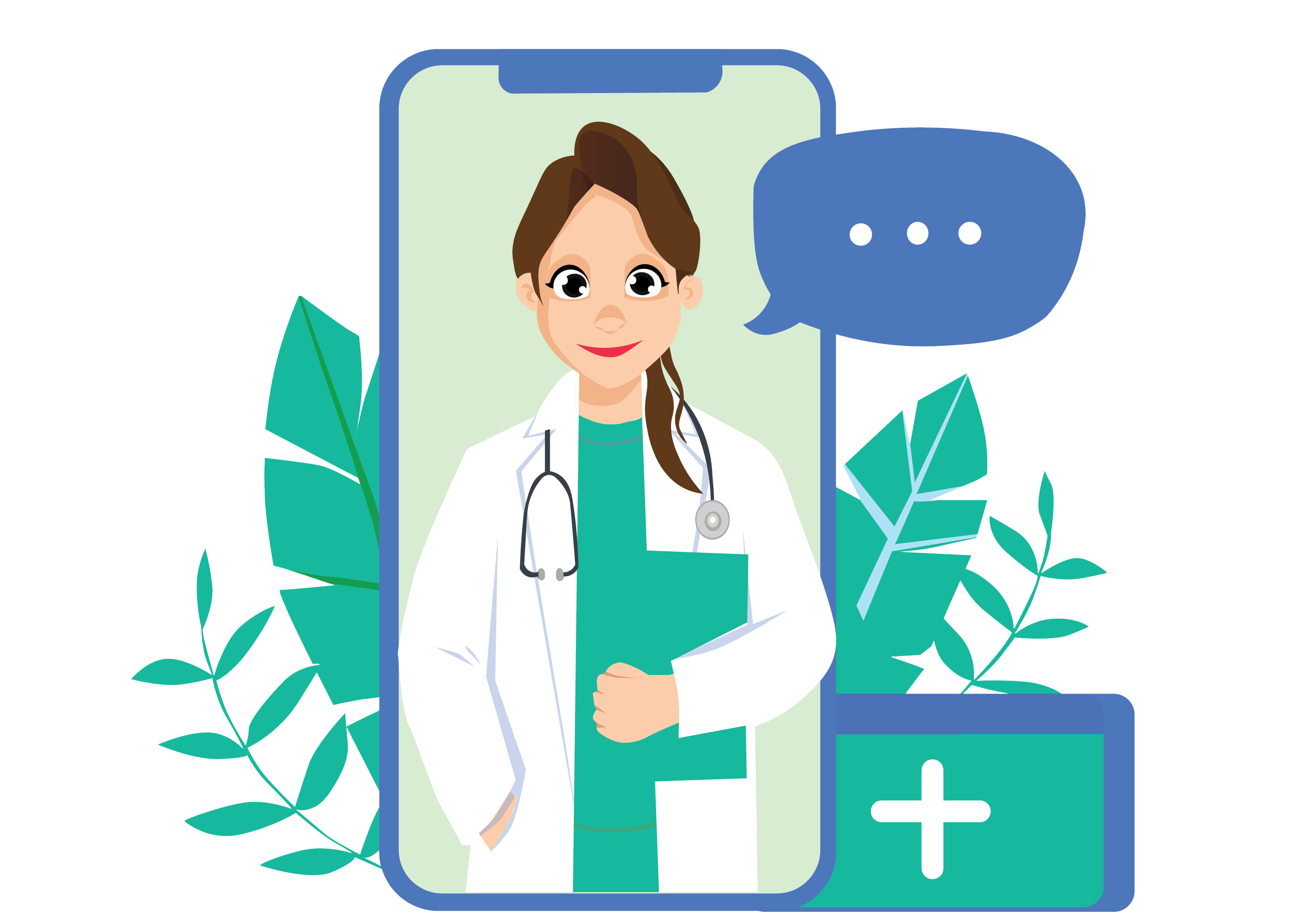
Choose your treatment.
From the list approved by the prescriber, choose your preferred treatment and then wait for it to be dispensed by UK Meds online pharmacy.
Receive your delivery
With next day delivery options available, you can have your treatment sent out to you discreetly within hours.Our Happy Customers
Rated Us for our Service Excellence
 Dispensed by Regulated UK Pharmacists
Dispensed by Regulated UK Pharmacists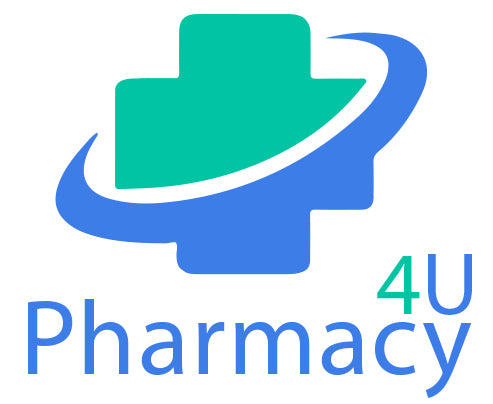

 How it works
How it works Help
Help Account
Account
 Basket
Basket





